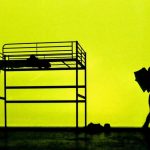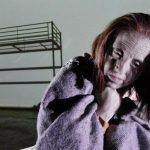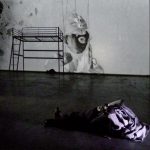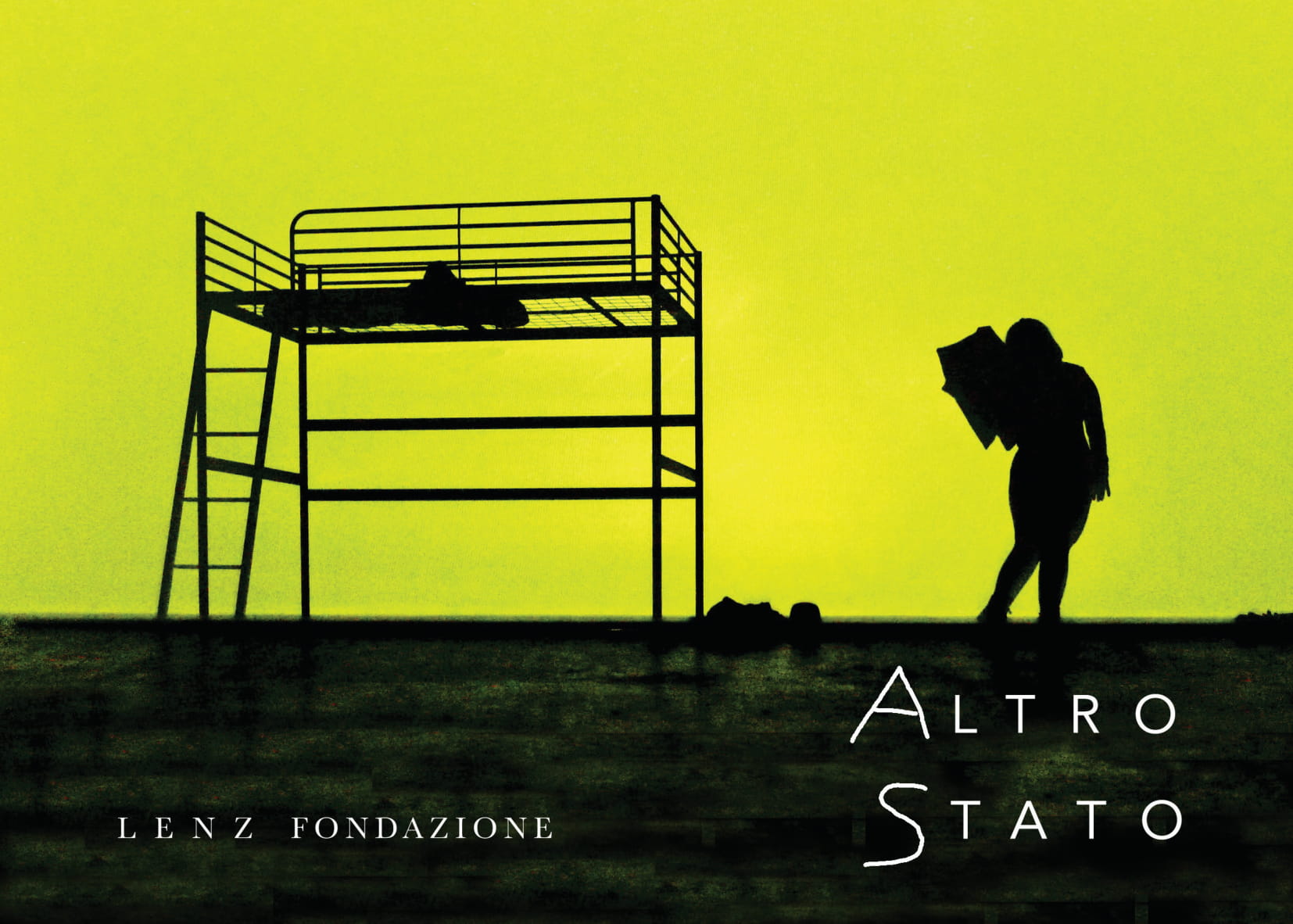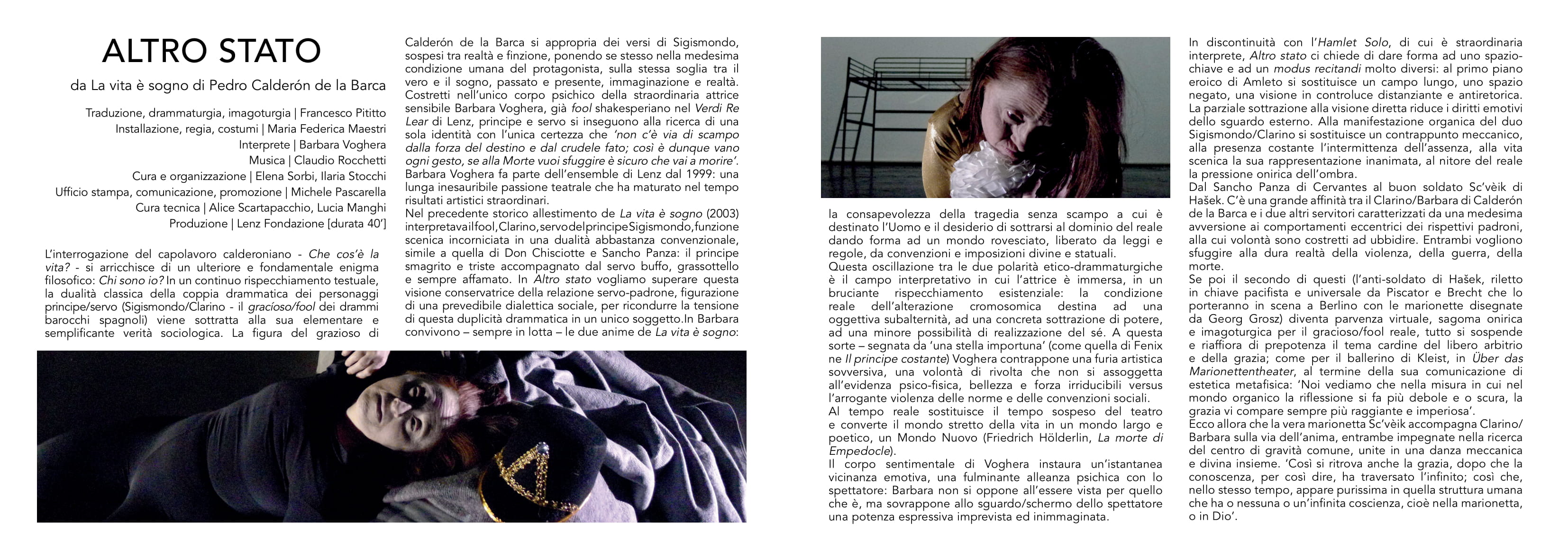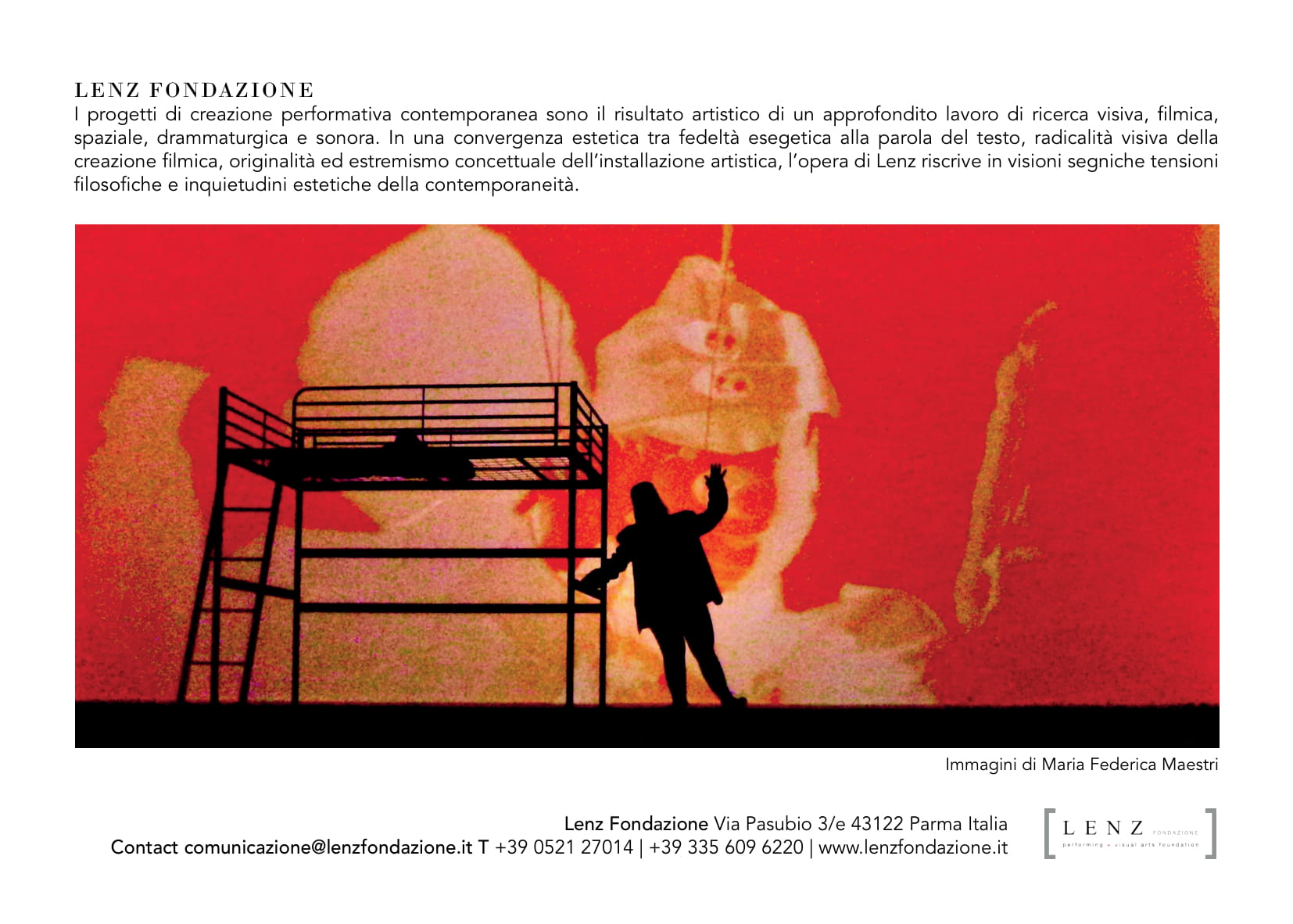
OTHER STATE (Other state)
The questioning of the Calderonian masterpiece – What is life? – is enriched with a further and fundamental philosophical enigma: Who am I?
In a continuous textual mirroring, the classical duality of the dramatic couple of prince/servant characters (Sigismondo/Clarino – the gracious/fool of Spanish baroque dramas) is subtracted from its elementary and simplifying sociological truth.
In an imitation mirroring, the figure of the gracious by Pedro Calderón de la Barca captures the verses suspended between reality and fiction of Sigismondo, placing himself in the same human condition as the protagonist, on the same threshold between truth and dream.
Forced into the only psychic body of the extraordinary sensitive actress Barbara Voghera, already Shakespearean fool in Verdi King Lear by Lenz, prince and servant chase each other in search of a single identity, with the only certainty that ‘there is no escape from the force of fate and cruel fate; so it is in vain every gesture, if you want to escape Death you are sure to die’.
Other state is embodied by the sensitive actress Barbara Voghera.
Barbara has been part of the Lenz ensemble since 2000: a long, extraordinary artistic friendship.
In the previous historical production of Life is Dream she played the fool, Clarino, Prince Sigismondo’s servant, a stage function framed in a rather conventional duality, similar to that of Don Quixote and Sancho Panza: the thin, tapered, anorexic prince and the chubby servant, always hungry. In Other state we want to overcome this conservative vision of the servant-master relationship, predictable social dialectics, to bring back the tension of duplicity into a single subject. In Barbara the two souls of Life is dream coexist – always in struggle -: the awareness of the tragedy without escape to which Man is destined (the hunger, the perennial suffering of the Poor in the auto sacramental of The Great Theater of the World) and the desire to escape the dominion of the real giving shape to an upturned world, freed from laws and rules, conventions and divine and state impositions (Man and the Arbitrator in the auto sacramental of The life is dream).
This oscillation between the two ethical-dramaturgical polarities is the interpretative field in which Barbara is immersed, in a burning existential mirroring: the real condition of chromosomal alteration destines to an objective subalternity, to a concrete subtraction of power, to a lesser possibility of self-realization.
To this fate – marked by ‘an annoying star’ (like that of Fenix in The constant prince) Barbara juxtaposes a subversive artistic fury, a will to revolt that is not subject to psycho-physical evidence, irreducible beauty and strength versus the arrogant violence of social norms and conventions. She replaces real time with the suspended time of theatre and converts the narrow world of life into a wide and poetic world, a New World (Friedrich Holderlin, The Death of Empedocles).
Barbara’s sentimental body establishes an instantaneous emotional closeness, a fulminating psychic alliance with the viewer: Barbara is not opposed to being seen for what she is, but superimposes an unexpected and unimagined expressive power on the viewer’s gaze/screen.
Unlike Hamlet Solo – another solo in which the actress is the protagonist, a show staged in prestigious monumental places, the last of which was the Farnese Theatre in Parma in 2019 – Other State asks us to give shape to a very different key space and modus operandi: the heroic close-up of Hamlet is replaced by a wide-shot in a strongly anti-rhetorical backlight. The partial subtraction from direct vision tends to deny the emotional right of the spectator, to his psychic dislocation in two dysfunctional dramatic fields. The organic manifestation of the Sigismondo/Clarino duo is replaced by a mechanical counterpoint, the constant presence by the intermittence of absence, the scenic life by its inanimate representation, the sharpness of reality by the dreamlike pressure of the shadow.
From Sancho Panza by Cervantes to the good soldier Sc’vèik by Hašek.
There is a great affinity between the Clarino/Barbara by Calderón de la Barca and the two other servants characterised by the same aversion to the eccentric behaviour of their respective masters, to whose will they are forced to obey.
They both want to escape the harsh reality of violence, war and death.
If then the second of them (Hašek’s anti-soldier, re-read in a pacifist and universal key by Piscator and Brecht who took him on stage in Berlin with the puppets designed by Georg Grosz) becomes a virtual semblance, a dreamlike and imagoturgical silhouette for the real gracious/fool, everything is suspended and the pivotal theme of free will and grace resurfaces with overbearance; as for Kleist’s dancer, in About the puppet theater, at the end of his communication of metaphysical aesthetics: “We see that to the extent that in the organic world reflection becomes weaker and darker, grace appears more and more radiant and imperious“.
Here then the true Sc’vèik puppet accompanies Clarino/Barbara on the path of the soul, both engaged in the search for the common centre of gravity, united in a dance both mechanical and divine “…so that grace is also found again, after knowledge, so to speak, has crossed the infinite; so that, at the same time, it appears very pure in that human structure which has either no or infinite consciousness, that is, in the puppet, or in God“.
Barbara Voghera has been the protagonist since the beginning of the year two thousand of some of Lenz’s most important performances projects, a central figure in Maria Federica Maestri and Francesco Pititto’s decades-long investigation into the renewal of contemporary stage language through artistic dialogue with otherness.
An exceptional performer in the various drafts of Hamlet (included in the international Global Shakespeares archive of the MIT – Massachussets Institute of Technology, an authoritative recognition of Lenz’s research on the sensitive actor), she is a multifaceted presence in Goethe’s Faust trilogy; an extraordinary performer in the first version of Life is Dream di Calderón de la Barca in the role of Clarino, a performance that was the subject of a study seminar within the most important Spanish Baroque Theatre Festival, she will be on stage again in the site-specific production at the Pilotta Monumental Complex for Parma 2020 | Italian Capital of Culture.
Among the many other roles performed in these twenty years of work, it is worth mentioning at least those of the protagonist in Snow White and Thumbelina in the Grimm Project (on tour in the major European capitals) and in Give us, child, your eyes taken from the opera by García Lorca Little Red Riding Hood; the Fool in the opera Verdi King Lear, special commission of the Verdi 2015 Festival and Bradamante in the two-year site-specific project inspired by Ariosto’s Furious Orlando. In 2019 she is on stage at the Teatro Farnese in Parma with Hamlet Solo, a powerful solo in which Voghera gives body and voice to the Shakespearean masterpiece. In 2019 she plays Orestes in Oresteia #2 Milk, from Eschilo.
OTHER STATE
from Life is dream by Pedro Calderón de la Barca
Translation, dramaturgy, imagoturgy | Francesco Pititto
Installation, direction, costumes | Maria Federica Masters
Interpreter | Barbara Voghera
Music | Claudius Rocchetti
Care and organization | Elena Sorbi, Ilaria Stocchi
Press office, communication, promotion | Michele Pascarella
Technical care | Alice Scartapacchio
Technical assistant | Marco Cavellini
Video Media | Roberto Gorreri
Production | Lenz Foundation
Duration | 50 minutes
trailer:
full video:
While Voghera plays both Sigismondo, who wonders if he is acting freely, and Clarino, who believes in freedom, the spectator sees a puppet moved by invisible threads represented in the background. The actress gradually becomes one herself: the invisible is transformed into visible, metaphysics into physics [more].
Enrico Piergiacomi, Theater and Criticism
The traditional question about life slips here with extraordinary sensitivity and naturalness in the question about one’s life, one’s subjectivity, which through the mirror and reflection can find a paradoxically more authentic dimension […] The sentimental body on stage therefore brings emotional closeness and an unusual signifying capacity about oneself. A show that rebels against the so-called reality, this so false, to identify the truth of the image and the imagined [more].
Maria Dolores Pesce, Dramma.it
Voghera sculpts the text, constructed in the form of a choice of verses from the original drama, fragmenting the syntax and reconfiguring its links, distributing it on textures and with agogics in constant contrast, often on a tone of tense energy [more] .
Carlo Lei, Krapp's Last Post
The limpid talent, the artistic maturity and the full performative dignity of the talented Voghera, a sensitive actress with Down syndrome, lead with truth and strength to a common subjective investigation, where the perpetual oscillation between different dramatic personalities (the ability of the interpreter in immersing himself in different figures of the work and in vocally coloring these passages), the constant contrast between what is and what appears (on the screen but also through the semantic allusive reference of some scenic objects, well recognizable and visible), clash-encounter between physical sincerity and imagined reality, between presence and absence, embodied in the psychic-body of the actress, place the very condition of the human Being at the center of the artistic organism [more].
Francesca Ferrari, Theaterpolis







